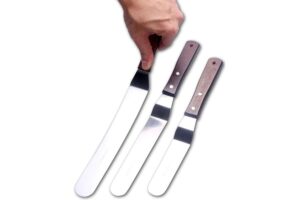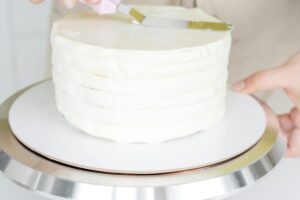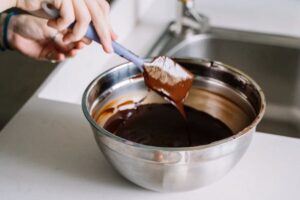Picture the offset spatula as the unsung hero in your kitchen—a trusty sidekick that brings precision and finesse to your culinary escapades.

It’s not just a tool; it’s your kitchen companion, ready to turn your baking and decorating dreams into reality. But what is an offset spatula good for exactly?
How do you choose the right size? What’s the difference between a regular and an offset spatula?
In this article, we’ll discuss the use of offset spatulas, how to choose the right size, and much more, so let’s jump right in!
What Is an Offset Spatula Good For?
An offset spatula is a versatile kitchen tool with a myriad of applications, making it an essential utensil for both professional chefs and home cooks. Here’s a detailed breakdown of what an offset spatula is good for:
Icing and Frosting Cakes
The offset design allows for easy and precise spreading of icing or frosting on cakes. The angled blade keeps your hand clear of the cake’s surface, ensuring smooth and even application.
Decorating Baked Goods
Ideal for intricate decorating tasks, the offset spatula is perfect for creating swirls and patterns or smoothing out the surface of cookies, brownies, and other baked goods.
Lifting and Transferring
The thin, flexible blade is great for lifting delicate items like cookies or thin cakes without damaging them. It provides the skill needed for transferring items from the baking sheet to the serving platter.
Handling Pastries
Whether you’re spreading cream on pastries or maneuvering delicate dough, the offset spatula’s precision and control make it an excellent tool for handling various pastry tasks.
Flipping and Turning
The thin, flat blade is perfect for flipping pancakes, crepes, or delicate fish fillets. Its flexibility allows you to get underneath without breaking the food.
Smoothing Batters
When making leveled layers for cakes or spreading batter in a pan, the offset spatula provides a smooth and even surface. This helps in achieving uniform cooking and baking.
Sandwich Assembly
Use the offset spatula to spread condiments, spreads, or fillings on sandwiches. The precision of the tool ensures an equal distribution of ingredients.
Release Stuck Foods
The offset shape is handy for gently loosening and releasing baked goods or other foods that might stick to surfaces, such as cookies from a sheet or brownies from a pan.
Chocolate Work
Perfect for spreading chocolate evenly when tempering or coating candies and confections. The spatula’s flat, smooth surface aids in achieving a professional finish.
Garnishing
Use the offset spatula to create elegant garnishes on plates. Its fine control allows for artistic flourishes with sauces, purees, or other decorative elements.
Cleaning Mixing Bowls
The flexible yet sturdy nature of the spatula makes it effective for scraping the sides of mixing bowls, ensuring you get every last bit of batter or dough.
Overall, the offset spatula is a kitchen multitool for tasks requiring precision, control, and a delicate touch.
The various applications of this product make it a valuable companion for a wide range of cooking and baking endeavors.
What Size Offset Spatula Do I Need?
Choosing the right size offset spatula depends on the tasks you plan to tackle in the kitchen. Here’s a detailed guide to help you determine the size that suits your needs:
Small Offset Spatula (4 to 6 inches)
Precision Work: Ideal for intricate tasks such as detailed cake decorating, spreading fillings on small pastries, or precise icing work on cupcakes.
Medium Offset Spatula (8 to 10 inches)

Versatility: A versatile choice for a wide range of tasks, including frosting medium-sized cakes, spreading batter in pans, lifting cookies, and flipping pancakes.
Large Offset Spatula (12 inches and above)
Bulky Tasks: Perfect for handling large cakes, leveling batter in oversized pans, or transferring multiple cookies at once. It offers efficiency for bigger batches.
Bread Offset Spatula (9 to 10 inches with a wider blade)
Bread and Cake Layers: Specifically designed for handling bread and cake layers. The wider blade aids in lifting and spreading frosting or fillings on larger surfaces.
Griddle Offset Spatula (6 to 8 inches with a tapered edge)
Flipping on Griddles: A spatula with a tapered edge is excellent for flipping pancakes, crepes, or delicate items on a grill due to its precision and flexibility.
Offset Spatula Set
Consider investing in a set that includes different sizes. This provides flexibility for various tasks and ensures you have the right tool for the job at hand.
Personal Preference
Consider the size that feels comfortable in your hand and provides the level of control you desire. Personal preference plays a significant role in choosing the right size.
Storage Space
Take into account the size of your kitchen and storage space. A smaller offset spatula might be more practical for those with limited kitchen real estate.
Task-Specific Spatulas
If you have specific tasks in mind, such as decorating cupcakes or working with delicate pastries, consider spatulas designed for those purposes, which may come in specialized sizes.
What Is the Difference Between a Spatula and an Offset Spatula?
Here’s a breakdown of the differences between a spatula and an offset spatula:
Design
Spatulas typically have a broad, flat blade with a straight edge, and they may come in various materials like silicone, metal, or plastic.
On the other hand, an offset spatula has a thin, flat blade with a slight angle or offset between the handle and the blade, offering better control and visibility.
Intended Use
Spatulas are versatile tools used for flipping, lifting, and turning items like pancakes, burgers, or cookies.
Conversely, offset spatulas are specifically designed for tasks that require precision, such as icing cakes, spreading fillings, or decorating pastries.
Application
A regular spatula is commonly used on grills, for flipping food in pans, or for scraping bowls. On the other hand, an offset spatula is primarily used in baking and pastry work for delicate tasks where precision is crucial.
Handle Placement
The handle of a regular spatula is typically in line with the blade, offering a direct, straight connection.
The handle of an offset spatula is slightly raised or offset from the blade, providing a better angle and making it easier to maneuver around obstacles.
Versatility
Spatula is more versatile for general cooking tasks and larger items. On the other hand, an offset spatula is specialized for detailed and delicate work in baking and pastry decoration.
What Can I Use Instead of Offset Spatula?
If you don’t have an offset spatula on hand, you can use the following alternatives:
Regular Spatula
A standard spatula can be used for flipping and turning items, although it lacks the precision of an offset spatula.
Butter Knife
In a pinch, a butter knife can be used for spreading icing on cakes or precision tasks, although it may not offer the same control.
Icing Knife
An icing knife or a flat-edged butter spreader can work for spreading frosting on cakes or decorating, though they might not have the same offset design.
Silicone Spatula

A silicone spatula can be used for some precision tasks and is gentler on non-stick surfaces.
Palette Knife
A palette knife, often used in painting, can serve as a makeshift offset spatula for decorating cakes and pastries.
Cheese Spreader
Similar to an offset spatula in shape, a cheese spreader can be used for smaller tasks like spreading fillings or icing.
DIY Offset Spatula
If precision is crucial, you can create a makeshift offset spatula by attaching a handle at an angle to a flat, thin piece of metal or plastic.
Conclusion
So, that’s the story of the offset spatula, your kitchen’s unsung hero. It’s not just a kitchen tool; it’s like having a trusty sidekick, making your baking adventures more fun.
Here’s to the offset spatula—making your kitchen moments extra special, one spread at a time!
